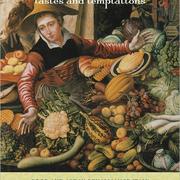
by John Varriano
University of California Press, 282 pp., $19.50
PETER LIEBERMAN
In 1505 the Florentine painter Andrea del Sarto, at a banquet held by the artistic and gastronomic confraternity known as ‘the Company of the Cauldron,’ presented a scale model of the Florence Baptistery to his fellow diners. Architectural models were becoming common at the beginning of the sixteenth century, but what made del Sarto’s achievement so spectacular was that his miniature Baptistery was entirely edible—made from cheese, marzipan, sausage, and various fowl. The painter’s creation perhaps represents the most direct intersection of culinary and visual art in the Renaissance, but it is the less material and more iconographical parallelisms in their development that are the focus of John Varriano’s exceedingly sharp and well-informed new work, Tastes and Temptations: Food and Art in Renaissance Italy. Varriano begins with the assertion that Renaissance appetites for art and cuisine arose from the same culture of humanism that was flourishing in Florence in the fifteenth century, which favored individual sensory experience over the strict Aristotelian categories that had dominated Western thought for better than fifteen-hundred years. Each discipline witnessed a dramatic departure from its medieval version: painting with the advent of linear perspective and a turn toward interpretational ambiguity, and gastronomy with the ability of farmers to finally draw more than a meager sustenance from the land. Varriano then righty proceeds thematically, rather than chronologically, exploring a different arena of artistic and culinary confluence in each chapter. These discussions range from sacrosanct to pornographic in subject, from somber depictions of the last supper, to still lives of provocatively arranged phallic gourds and bursting figs. Of particular interest is the chapter dedicated to regionalism, which treats the “shared geography of art and cuisine.” He makes the argument that just as agricultural production is entirely dependent on local soil conditions and microclimates, the development of art, and especially architecture, is equally a reflection of regional geography. Varriano’s point is well taken, and supported by several rich examples. A natural abundance of the dark ‘pietra serena’ in the Arno river valley essentially created the bichromatic decorative effect commonly associated with Brunelleschi and fifteenth-century Florence, while the seemingly unending Sicilian sunshine explains that region’s preference for “robustly columnar and curved façades.” After a fascinating comparison of ‘Venetian Red’ made famous by Titian and Tintoretto and the color of local radicchio (which ultimately does not hold up to the author’s own scrutiny), the section culminates with a citation of John Onians, who suggests a uniquely and exclusively Florentine origin of linear perspective: the technique could not have developed in Rome with its jumbled ruins, or in Venice’s labyrinth of canals and alleys, but only in the arrow-straight streets and classical grid-layout of Florence. Varriano then chimes in with a charming touch, comparing the prominence of right angle intersections in the city to the T-shaped bone of the beloved Florentine specialty, bistecca alla fiorentina. Even when his suggestions are downright implausible, to say the least, there is something about the author’s style and approach that always manages to evoke a smile rather than a grimace. Varriano remarkable perceptiveness is matched by the quality of his prose, which together enable him to consistently provide compelling and concise recapitulations of matters wholly outside his field of study: “Witty puns flourished in the sixteenth-century, when political and spiritual instability led to unresolved tensions between a nominally empirical way of thinking and an underlying propensity for allusion and dissimulation.” Varriano seems quite sure of his audience, and his tone remains constant throughout the work—he is not aggressively trying to convince the reader of the validity of some point that might otherwise be doubted, but rather he sensitively gives us an informative education in the subject that interests him. That Varriano is highly learned in all matters Renaissance, or at least that he maintains the illusion of erudition, is a great asset and part of what makes Tastes and Temptations a ringing success.
